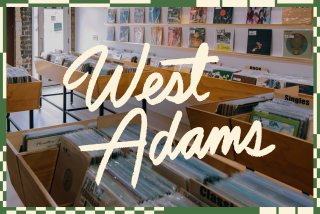‘It was that kind of iconic childhood where kids were just always outside’

Kwong family
The long perfectly seamless driveway that extended in front of the Kwong family’s home on Los Angeles’ 39th Street drew all the neighborhood kids.
“We were famous for our driveway,” recalled Dan Kwong, 60, a solo performance artist and writer-director. “I can remember seeing strange kids roller-skating in our driveway, and it was like, oh well, we understand. Everyone wants to skate in our driveway.”
Kwong and his family lived at this location for five years.
“I remember it being a very friendly neighborhood where we hung out at each other’s houses and there didn’t seem to be any kind of tension between the ethnic groups at that time,” Kwong said.
“It was that kind of iconic childhood where kids were just always outside,” said Dan’s sister Maria, 63, now director of retail enterprises at the Japanese American National Museum.
“We were all outside as a group doing a lot of things until the sun went down, until our parents made us go into the house. We were always out and always with a lot of different kids. It was great. I don’t remember race being a thing in our neighborhood.”
That wasn’t always the case when the family moved to Silver Lake in 1960. It was then a working class neighborhood made up of mainly Asians and African Americans, and an area without any sidewalks.
“At that time you could live in certain areas and that was the most popular area for Chinese,” said Sam Kwong, 85, the family patriarch and a retired accomplished commercial photographer who emigrated from China.
“There, there was a lot more racism floating around between ethnic groups,” Dan Kwong said. Most of it appeared aimed at Latinos, he recalled.
The Kwongs were a mixed Chinese Japanese family, a rarity following the years of the Second World War, when animosity between the two nations remained high.
But Sam Kwong was not deterred from marrying a Japanese American woman (the couple later divorced.) He described himself as “a rebellious type of guy” who was “pretty much self-determined.”
Dan Kwong, the only boy of four Kwong children, said he never felt fully accepted by his Chinese or Japanese peers and this had the effect of making him feel somewhat separated from other Asians. And in many ways, “growing up I identified [as] white culturally,” Dan Kwong said.
“Plus at that time we were heavy TV kids and at that time that’s all we saw on TV…. white people, except for the very occasionally, stereotypical people of color,” Kwong said. So for me my culture heritage was something I consciously or subconsciously repressed for most of my life until I reached young adulthood.”
Not so for Maria Kwong.
“I feel like I did know who I was,” Maria Kwong said. She would go to Little Tokyo, participate in the annual Japanese “Nisei Week” festival in Little Tokyo and indulge in Japanese and Chinese food.
“That was the one way that our parents did keep us connected to some part of our heritage,” she said, noting that her mother wondered whether the children should attend Chinese or Japanese school, but her father retorted: “Why? They live in America, they should speak English.”
Using his talent for photography, every Christmas Sam Kwong would get his kids to pose for a family photograph, which was distributed as a card to friends and family. There was typically a theme. One year the children dressed up as cowboys and Native Americans posing in front of a tepee.
Dan Kwong wore a beat-up cowboy hat, a plaid flannel shirt and a belt with a big oval buckle.
“To me a cowboy was quintessentially American,” he said. “I really identified with that.”
“I kinda think I wanted to be a cowboy as well, but…. I had the longest hair so I had to be an Indian,” Maria Kwong said. Still, she and her sister were excited because “we got to wear our mother’s jewelry.”
Follow me on Twitter for the latest in video & multimedia reports: @AMSimmons1
Follow @LookBackLA on Twitter.
More to Read
Sign up for Essential California
The most important California stories and recommendations in your inbox every morning.
You may occasionally receive promotional content from the Los Angeles Times.











